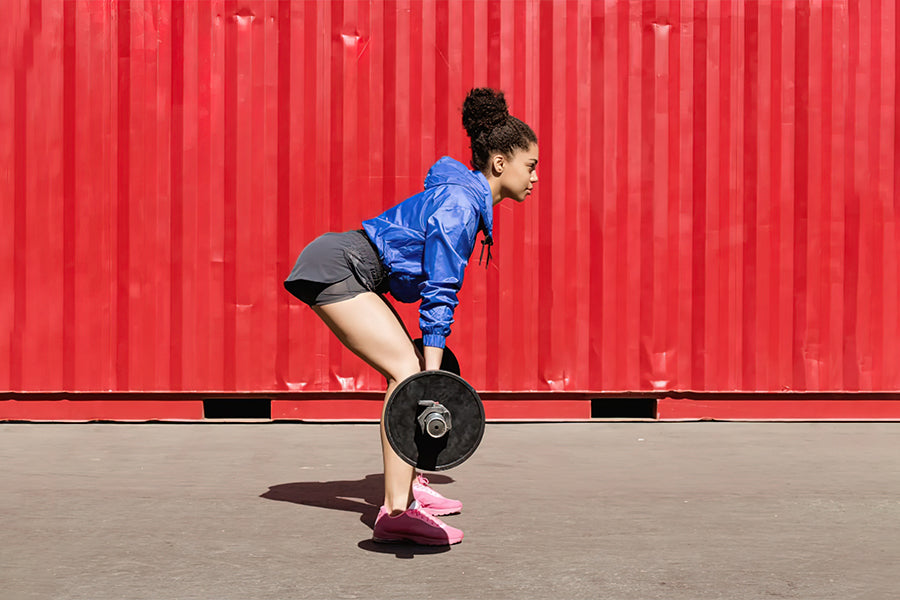Why did the weightlifting bar go to therapy? Because it just couldn't handle all the weight of everyone's problems! Ba-dum-tss!
Now that we've got that out of the way let's dive into the world of weightlifting bars and discover the ten types that will leave you questioning whether we've gone too far in pursuing gains. So, strap on your lifting belts and prepare for a wild ride as we explore the question keeping gym rats up at night: "Which weightlifting bar is best for you?"
Don't worry if you're overwhelmed by the mere thought of different types of bars. We're here to break it down for you, one hilarious punchline at a time. Let's lift the veil on these mighty bars and see what they store for us.
From the Swiss bar that sounds more like fancy chocolate than a piece of workout equipment to the deadlift bar that's so flexible it might as well join Cirque du Soleil, we're about to embark on a whirlwind tour of weightlifting bar madness.
But wait, there's more! Get ready to meet the trap bar, the barbell that's so edgy it's practically a punk rock icon. Or how about the axle bar, the barbell version of "go big or go home," whose massive diameter screams, "I mean business!"
And let's not forget the EZ curl bar, the bar that's here to save your wrists from the perils of straight bars, because who needs normal when you can have curvy, right? So, my fellow fitness enthusiasts, prepare to have your minds blown, your funny bones tickled, and your workout routines forever changed.
Because in this weightlifting bar extravaganza, we're going beyond the ordinary, defying expectations, and injecting a healthy dose of laughter into the iron-clad world of strength training.
So, hold onto your six-pack abs because we're about to embark on a journey filled with gains, giggles, and weightlifting bar shenanigans. Get ready to lift your spirits and those heavy weights because the world of weightlifting bars just got much funnier! Let's do this!
What are Weightlifting Bars?
Weightlifting bars, typically constructed from durable metal, serve as essential tools for lifting weights. These bars feature ends designed to hold weight plates, enabling lifters to customize the load according to their preference and training goals.
While the core concept of weightlifting bars remains straightforward, the market offers various barbells tailored to specific purposes. Regardless of the specific type, the primary purpose of a barbell is to challenge the muscles and stimulate strength and muscle growth.
To decide on the type of barbell that suits your needs, refer to this comprehensive list that provides an overview of available options. Explore the possibilities and choose the weightlifting bar that aligns with your fitness objectives.
Related Article: The Ultimate Guide to Choose the Best Pull-Up Bar for Your Door Safety
12 Types of Weightlifting Bars
Now, let's explore a range of 12 weightlifting bars, starting with the widely used straight bars for better organization. Following that, we will delve into an assortment of specialized bars.
In our discussion of specialty bars, we will first present the most common types. Still, it's important to note that the availability and order of barbell variations may vary depending on different locations and facilities. So, let's dive in and discover the diverse world of weightlifting bars together!
1. Open Barbell

The open barbell, or a barbell with open-ended sleeves, offers a convenient and efficient solution for quickly loading and unloading weight plates during workouts. Unlike other barbells, it does not require collars to secure the plates, saving time and effort.
Typically weighing around 20 kilograms (44.09 pounds) for men's bars and 15 kilograms (33.07 pounds) for women's bars, the open barbell is designed to be versatile and adaptable.
It allows athletes and fitness enthusiasts to easily adjust the weight according to their specific training needs, making it ideal for progressive overload exercises that require incremental weight increases.
The simplicity and time-saving nature of the open barbell make it a popular choice in various fitness disciplines, including weightlifting, powerlifting, and functional training. It is suitable for various squats, deadlifts, bench presses, and overhead presses.
If you want to incorporate an open barbell into your training sessions, consider the DMoose open barbell. This 45 LB barbell adheres to standard specifications in length and diameter, making it compatible with various exercises, particularly squats.
It features knurled hand grips for a secure hold, sleeves to hold weight plates securely, and is constructed from high-quality steel with a solid tensile strength rating of 150K psi, allowing it to withstand a maximum load of 1000lb.
The DMoose open barbell is built to last, with a defensive back phosphate coating on the shaft and chrome coating on the sleeves to prevent wear and oxidation. Additionally, it is equipped with silicone rings that serve as color-coded identifiers, making it easy to differentiate between different weights.
Incorporating the DMoose open barbell into your weightlifting and strength training routines can enhance your workouts, providing a reliable and efficient tool to achieve your fitness goals.
2. Olympic Bar
The Olympic barbell has become the new standard in weightlifting. These 7ft long bars typically weigh 20kg (44 lbs) for men and 15kg (33 lbs) for women. They feature a 28mm diameter shaft and 2-inch rotating collars, distinguishing them from standard barbells.
The rotating collars of the Olympic barbell are what sets them apart. During lifts, weight plates experience inertia and tend to rotate. Fixed collars can also cause the bar to rotate, leading to wrist strain or even dropping the bar. The spinning collars of the Olympic barbell allow the plates to rotate while keeping the bar stationary, ensuring optimal lifting form.
The Olympic barbell is specifically designed for Olympic lifts like the clean and jerk, where rotation is crucial. It has light knurling to facilitate spinning during the lifts, while the center and outer portions remain smooth to prevent skin abrasions when the bar lands on the chest or shoulders.
In terms of versatility, the Olympic barbell is considered one of the best all-around bars, making it a popular choice.
Regarding weightlifting, the Olympic barbell provides the ideal combination of length, weight, rotating collars, and specialized design for optimal performance in various lifts.
3. Powerlifting Barbell

Powerlifting barbells are available in various weights to meet specific needs and training requirements. The standard weight for men is approximately 44.09 pounds, while for women, it is around 33.07 pounds.
However, manufacturers offer different weight variations to cater to diverse training scenarios.
Powerlifting barbells can range from as light as 22 pounds for women or for technical training purposes to as heavy as 55 pounds for men, depending on specific needs.
It's important to consider that the barbell's weight alone is just one aspect, as the total load lifted also depends on the weight plates added to the barbell.
Designed to handle heavier weights than Olympic barbells, powerlifting barbells excel in power lifts like the deadlift, which becomes increasingly challenging at the competitive level.
They feature slightly closer and more rigid grips compared to Olympic barbells. Unlike Olympic barbells, power bars lack rotating sleeves, essential for specific Olympic lifting movements.
Powerlifting barbells are ideal for strength training, specifically targeting muscle strength and size development. They are commonly used for bench presses, deadlifts, and squats.
To enhance your workouts and endure heavy loads, the DMoose powerlifting barbell is a great addition. It boasts a high tensile strength rating, empowering you to push your limits and enhance performance.
With its durable construction, protective coatings, and sleeves, the DMoose barbell is designed to withstand wear and tear.
The knurling pattern ensures a secure grip, providing stability and confidence during lifts. The barbell offers ample loadable space and an impressive weight capacity, allowing it to handle demanding workout routines while prioritizing safety.
4. Regional Barbell
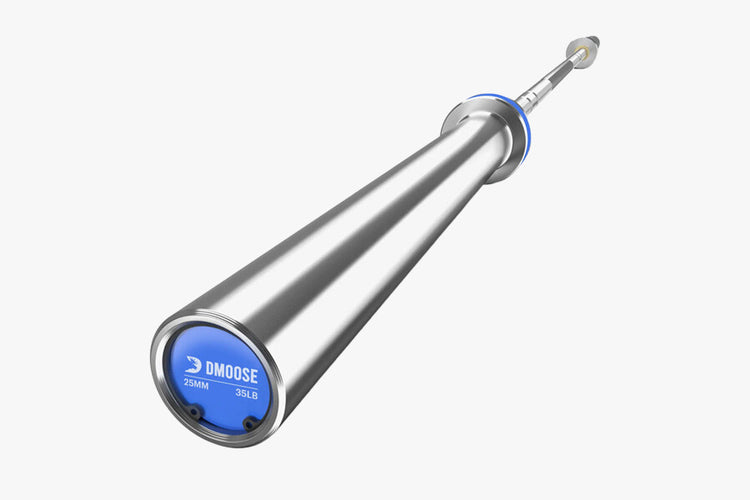
A regional barbell is specifically designed for regional and local weightlifting competitions, adhering to strict standards and specifications. Weighing around 20 kilograms (44.09 pounds), its standardized weight ensures fairness and consistency in these competitions.
What sets the regional barbell apart is its focus on meeting the specific requirements of regional events.
It features a standardized length and diameter, ensuring consistent performance for all athletes. With its reliable design, the regional barbell provides competitors with a consistent lifting experience, allowing them to perform at their best.
Constructed with durability and performance, the regional barbell is typically made from high-quality materials like top-grade steel. This enables it to handle heavy loads and intense training sessions. Some regional barbells may also incorporate precision needle bearings, facilitating smooth rotation and improved control during lifts.
The DMoose regional barbell is a versatile and high-quality piece of equipment tailored to meet the demands of regional and local weightlifting competitions.
Crafted with precision, it adheres to the strict standards and specifications required for competitive lifting.
The regional barbell delivers optimal performance and longevity with its durable construction using top-grade steel. Its precise weight of 20 kilograms (44 pounds), standardized length, and diameter ensure a consistent lifting experience for athletes.
Engineered with precision needle bearings, the barbell allows for seamless rotation, enabling athletes to perform dynamic movements and lifts with enhanced control and stability.
5. Safety Squat Barbell
A squat bar is a specialized barbell designed specifically for squats, typically weighing more than a standard Olympic barbell. The weight of the barbell in this category can vary. One popular type is the safety squat bar, commonly found in commercial gyms, weighing around 55 pounds.
Safety squat bars feature shoulder and arm pads, providing additional comfort and support during squats. These specialized barbells have a unique design with a curved central bar and handles, offering an ergonomic grip while performing squats.
They are particularly beneficial for individuals with limited shoulder mobility or those recovering from injuries. Using a safety squat bar, athletes can maintain an upright posture during squats, reducing strain on the lower back and shoulders.
The weight of safety squat bars can differ, but they generally exceed the weight of standard barbells, with some models weighing up to 65 pounds.
It's important to distinguish safety squat bars from deadlift bars, as the latter has a narrower diameter shaft and lighter weight.
However, the safety squat bar can still be effectively used for deadlifts and is especially useful for improving squat form and technique using a regular straight barbell.
The primary purpose of a safety squat bar is for heavy squats, offering a safer and more durable equipment option compared to standard barbells.
Adding a safety squat bar to your training routine can enhance your squat performance while providing additional safety and comfort.
Related Article: 6 Uses of Barbell Squat Pad in Weightlifting
6. EZ Curl Bar
A fixed bar is commonly used for barbell curls, offering a specific design for targeting the biceps. These bars are shorter than standard barbells and may have weights permanently attached to the ends.
There are typically two types of fixed bars available:
The first type is the straight bar, characterized by its square shape with a knurled pattern along the length. This design allows for a secure grip during curls, promoting stability and control.
The second type is the EZ-curl bar, which features various angled cuts along its structure. The unique shape of the EZ-curl bar enables a more ergonomic grip, reducing strain on the wrists and allowing for a comfortable lifting position.
By minimizing wrist discomfort, individuals can lift heavier weights safely and effectively.
7. Trap Bar
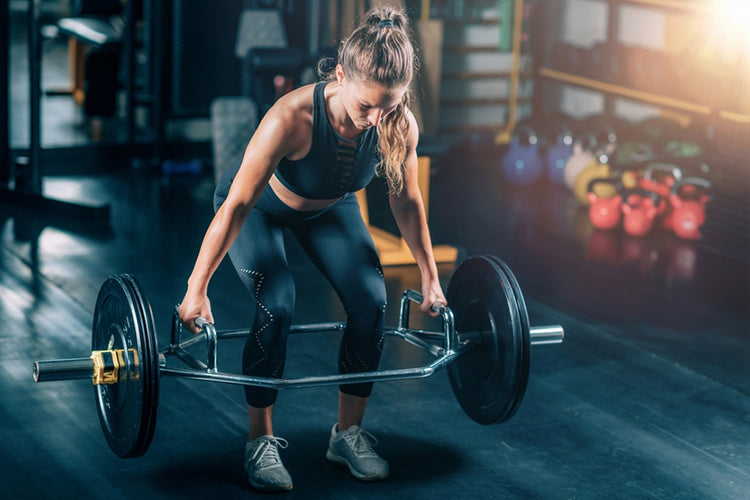
The trap bar is a specialty bar that offers a unique lifting experience distinct from squats. Unlike other bars, you don't squat with the trap bar; instead, you pick it up with your hands.
The trap bar features a distinctive hexagonal shape with long collars extending from the ends. Inside the hexagon, two handles are positioned for a secure grip. This design allows individuals to step inside the trap bar and grasp the handles, facilitating various exercises.
Trap bar deadlifts and frame carries are common movements performed with this bar. Also, lifters can modify their biomechanics to emphasize a squat-like (quad-dominant) or deadlift-like (hamstring-dominant) movement pattern.
While the shape of the trap bar remains consistent, the weight of hex bars can vary between 45 to 65 pounds, so it's essential to verify with the manufacturer.
The trap bar is special in our routines, and we highly appreciate its versatility and functionality.
8. Swiss Bar
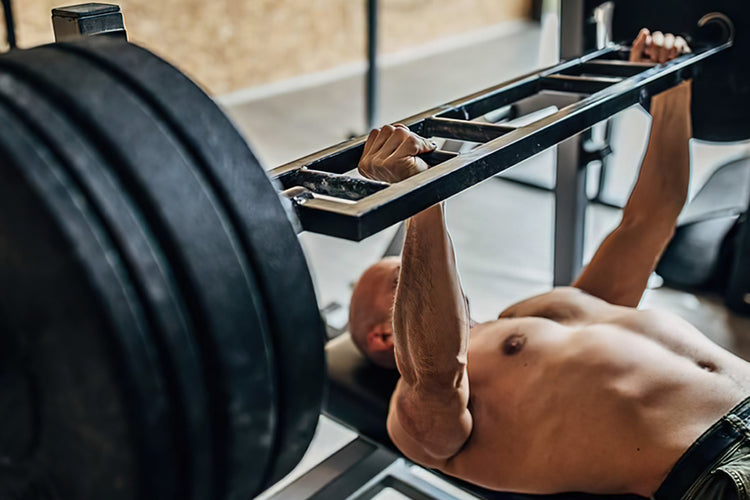
Consider yourself fortunate if you can use a Swiss bar in your strength and conditioning facility. These versatile bars have gained popularity and are highly valued for their unique features and benefits.
The Swiss bar, also known as a multi-grip bar, is designed explicitly for upper-body movements and provides a range of gripping options. Weighing between 25 to 35 pounds, this bar allows for a neutral grip and offers offset grips at different angles, catering to various exercise preferences and hand positions.
The bar has a distinctive rectangular shape in the middle section, where the multi-grips are located. These grips provide versatility and comfort during exercises.
The Swiss bar typically features fixed collars that do not spin, ensuring stability and control during lifts. One notable advantage of the Swiss bar is its ability to facilitate a neutral grip, benefiting individuals with elbow pain or those aiming to target the triceps more effectively.
It excels in exercises such as bench presses, floor presses, and overhead presses from pins, as it allows you to select the grip that best suits your hand size and workout goals.
It stands out with its long loadable sleeve length of 16.5 inches, providing ample space for adding weight plates and building muscle. Its Olympic-grade construction guarantees durability and enables it to withstand even the most demanding and intense workout sessions.
9. Deadlift Bar
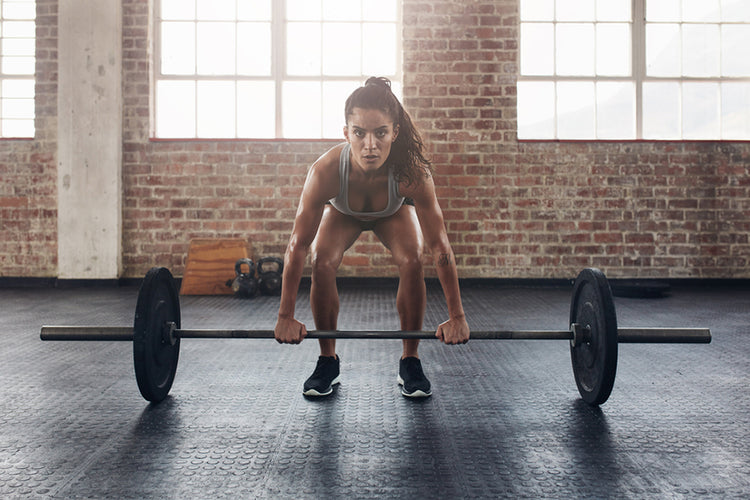
When explaining the concept of a deadlift bar is quite similar to standard Olympic bars but with a notable difference in the level of flexibility, commonly referred to as "whip."
These bars typically adhere to the standard dimensions of Olympic bars, measuring 7 feet (84 inches) in length, weighing 45 pounds (20 kilograms), and having a diameter ranging from 27mm to 29mm.
The key distinction of a deadlift bar lies in its increased flexibility. This means that when heavy weights are loaded on the bar, it exhibits more bending or flexion.
As a lifter initiates the upward pull in a deadlift, the weight plates remain grounded momentarily while the middle section of the bar bends or flexes. Eventually, the load catches and breaks away from the ground.
When executed correctly, this bar design allows for lifting heavier weights from the floor, potentially leading to new personal records (PRs). Once you experience using a deadlift bar, transitioning back to conventional bars may prove challenging, as the deadlift bar's unique characteristics provide certain performance advantages.
Related Article: How to Choose the Best Barbell for Your Weightlifting Needs
10. Axle Bar
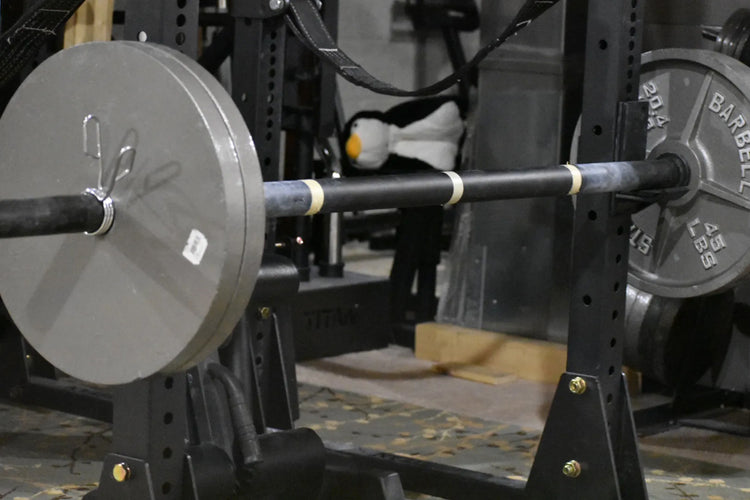
The axle bar is a barbell primarily found in strength-focused gyms catering to Strongman athletes. Axle bars can vary in size, but their main characteristic is a thick bar with a diameter typically around 2 inches.
Most axle bars weigh 45 pounds or 20 kilograms, similar to standard Olympic bars.
A distinguishing feature of the axle bar is its fixed collars. Unlike other barbells with spinning collars, axle bars have collars that do not rotate, significantly increasing the difficulty of lifting weights.
Typically, when momentum builds, the weight plates move independently while the bar remains stationary.
However, with an axle bar, any inertia applied to the weight plates causes the entire bar to want to rotate.
Despite this unique challenge, the axle bar can still be used for a wide range of exercises you would typically perform with standard bars. Some movements, like the continental press, are specific to the axle bar, while others can be interchanged within the same training program to provide a different training stimulus.
Related Article: What's the Importance of Thick Grip on Bars and Dumbbells?
Conclusion
The world of barbells offers diverse options to cater to different training needs and preferences. From open barbells designed for quick weight adjustments to Olympic barbells built for competitive lifting events, each type serves a specific purpose in strength and conditioning.
Specialty barbells such as powerlifting, regional, squat, trap, Swiss, deadlift, and axle bars bring unique features and benefits to enhance specific exercises and target different muscle groups.
These bars are designed with careful consideration for factors like weight, grip, flexibility, and functionality to optimize performance and safety during workouts.
Whether you're an athlete, a fitness enthusiast, or someone aiming to improve strength and muscle development, having access to various barbell options can significantly enhance your training experience. Choosing the right barbell can make a notable difference in achieving your fitness goals and progressing towards new personal records.
Reading List
How to Use a Thick Bar Bomber Grip
A Full-Body Barbell Workout for Beginners That Can Build Your Gym Confidence
Top 10 Essential Barbell Exercises for Building Muscle and Strength
4-Day Barbell Workout Without a Rack for Complete Muscle Gain









